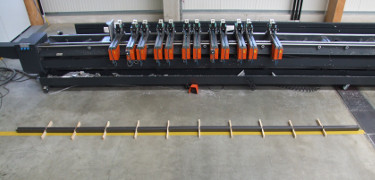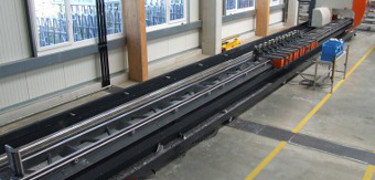Save material and time, note the number of fixtures, take fixture travel paths into consideration

Less waste – more profit: Saving material with bar optimisation increases profits. But bar optimisation sometimes has other purposes, too: For example, making the order feasible with the number of fixtures available.
The “Bar optimisation” module offers lots of advantages
Anyone who works with cut optimisation verbrauchtless material – and that increases profits: The advantages of bar optimisation are obvious. However: Bar optimisation doesn’t always have the goal of reducing material consumption – sometimes optimisation is also desirable in terms of “Clampability of single parts”, “Possible paths for fixtures” or “Speed of the processing program”. The eluCad module “Bar optimisation” has solutions for all these application cases.
There are numerous reasons to use the bar optimisation module in eluCad:
1. Material and cost savings
Effective use of expensive raw material increases the value created in the process chain. Example: Assuming that a profile rod costs 150 Euros and bar optimisation lets you save two rods each working day – then in a single month your savings will already come to about 6,000 Euros.
2. The fewest cuts possible
Waste pieces have to be tallied against the scrap price. Why buy profiles high and then sell returns for a scrap price? The shorter your residual parts and the lower the amount of waste, the more positive the company’s balance sheet.
3. Fewer storage slots
Anybody storing rod remainders needs lots of space. If you’re using different profile types, you will quickly end up with a large number of very small storage slots that make it difficult to keep an overview. Not to mention: The rod remainders have to be found quickly when they’re used. And every rod remainder has to be stored in such a way that it doesn’t get scratched and can be used later.
4. Time savings
You can saw on the saw and then carry the parts to the processing centre. But things go faster when instead of two machines, you only use one: One rod processing centre that can process not only single parts that are already cut to length, but can process entire raw rods. The eluCad bar optimiser sorts parts of an order by identical clamping points.
5. Better safety
The eluCad bar optimiser avoids the risk that large parts of the rod could fall into the machine bed and lead to damage.
6. Establishing feasibility
The eluCad bar optimiser then takes the fixture options on the machine into consideration. That applies to the number of fixtures as well as their paths.
7. Simplifying work preparation
The eluCad bar optimiser calculates how many rods are needed for the job. The module can in principle also calculate whether it is more cost-effective to purchase longer raw material because less cutting would be required. To do this, the user simply enters the rod lengths available for selection and starts the calculation with the eluCad bar optimiser.
The eluCad bar optimiser module also addresses additional application cases in bar optimisation:
– You’re using a bar optimisation program from another provider – for example, from a window construction program. The single parts also arranged in a material-saving manner on the profile rod by this program – but your machine doesn’t have enough fixtures to hold all these parts and the rod remainder? The eluCad bar optimiser makes pre-optimised rods feasible by taking the number of fixtures on the target machine into consideration.
– The bar optimisation program of another provider – for example your window and facade construction program – makes a suggestion for arranging the single parts on the profile rod. You actually have enough fixtures on the machine to hold all the parts and the rod remainder – but you still can’t implement the program because not all the fixtures can move far enough over the whole length of the machine bed as would be necessary. Again, the eluCad bar optimiser has solutions that take the possible travel paths of the fixtures into consideration and make the calculated processing program feasible.
– You’re not even worried about saving as much material as possible – you’re more interested in producing quickly? Perhaps you’re even willing to increase the size of waste pieces between single parts on a rod to speed up fabrication? Here, too, the rod optimisation module of the eluCad programming software offers a solution.
License for optimisation
The following text describes bar optimisation on an elumatec rod processing centre that can work not only with pre-sawn single pieces but rather with entire raw rods – such as the SBZ 151 5-axis centre. Very efficient work is possible with this machine. The eluCad bar optimiser is available for any customer working with such a 5-axis machine and have the “Bar optimisation” module.
Fixture consideration on the target machine
To cover a wide variety of application cases in practice, there are two basic options the eluCad bar optimiser can use: First, “Cut optimisation without fixture consideration of the target machine”, and second “Cut optimisation with fixture consideration of the target machine”.
Cut optimisation without taking fixtures into consideration is provided, for example, by some window construction programs. These bar optimisations are sufficient when profiles are sawn into single pieces on a separate saw. However, it generally makes a difference whether bar optimisation is calculated for a saw or for a rod processing centre as the target machine. A saw can cut very small parts and work without fixtures that have to hold partial pieces – so optimisation can be carried out differently for a saw than for a profile processing centre. The machine-specific equipment of a rod processing centre, for example, includes the number of fixtures as well as their travel paths: frequently, not all fixtures can be moved along the entire length of the machine bed. This has consequences for bar optimisation.
Pre-optimised rod is split up
If a customer – for example by using a window construction program – has already carried out a cut optimisation without taking fixtures into consideration, this result can still be further processed by the eluCad bar optimiser. The profile rod and its layout of partial pieces can be imported into eluCad. The eluCad bar optimiser then takes the fixture options on the target machine into consideration and if necessary breaks the pre-optimised rod up so that the program is feasible on this machine. Dividing rods that have been pre-optimised in external programs by allowing eluCad to take fixtures into consideration can sometimes lead to a worse result than simply allowing the eluCad module “Bar optimisation” to calculate “Cut optimisation with fixture consideration” directly. “Poorer result” means that more rods will be needed.
Cut optimisation with fixture consideration
But how does cut optimisation with fixture consideration work in the eluCad bar optimisation module? As usual, a specific customer request was the original motivation to develop this solution for production-specific tasks. The starting situation: An elusoft customer wanted to saw a 7,000 mm long profile rod into many small pieces whose number had been calculated by an external bar optimiser. On the rod program centre, each piece and also the remainder of the rod had to be held by two fixtures – but there weren’t even close to that many fixtures available on the machine. Moreover, not all the fixtures could move over the full length of the machine bed – some elumatec machines have a length of over 16 m.
The elusoft specialists then developed a solution that takes all machine-specific equipment into consideration and permits bar optimisation in which no more cuts are made than absolutely necessary.
Two options
The eluCad module makes the bar optimisation feasible with the number of fixtures that are actually available on the machine. In principle there are two options for how the calculated bar optimisation can be implemented: With the “Bar Splitter” program, or with the “Bar Optimizer” program.
In the bar splitter program, the profile rod is pushed to the left stop of the machine bed, then bar optimised rod processing starts: The first piece is held by at least two fixtures and is processed and sawn off the rod – then comes piece 2, piece 3, and so on. Bar optimisation then keeps running until all the fixtures available on the machine are in use, either to hold pieces or to hold the rod remainder. Without fixtures, the rod remainder can no longer be processed and the machine stops.
The machine operator now takes the finished pieces from the machine bed and pushes the rod remainder back to the left stop of the machine bed. The program now lays out this remainder with the remaining pieces for this rod. The eluCad rod optimisation program then continues until the rod has been divided as far as possible into the pieces needed. Only the unavoidable cut waste remains.
 The result: The entire rod is processed and sawn. The eluCad module makes it possible – even if there are too few fixtures for the processing planned. |
In this bar splitter program, the software generates additional programs whenever the rod remainder is pushed to the stop. The program sequence is displayed on the screen of the control panel. The machine operator thus sees that in this program he must push the rod remainder to the stop when bar optimisation no longer has enough fixtures available.
Program calculates the offset
In the bar optimiser variant of bar optimisation, the machine operator must place the profile rod into an area of the machine bed that – depending on the partial program to be produced – can be reached by as many fixtures as possible. The program takes the possible travel paths into consideration to calculate the optimum position for the profile rod and shows the machine operator the so-called “X-offset”. This X-offset is the distance between the stop plate at the zero point of the machine and the start of the profile. When the profile – as shown by the program – is inserted, the processing program starts again. Only the unavoidable cut waste remains.
 The problem: The machine actually has enough fixtures to process the entire rod. But it still doesn’t work because not all the fixtures can travel as far as they would need to do. |
 The solution: The eluCad module calculates the area on the machine bed that can be reached by the most fixtures and is therefore the most suitable for the planned rod processing. The distance from the stop to the start of the profile – the so-called X offset – is shown to the machine operator. |

